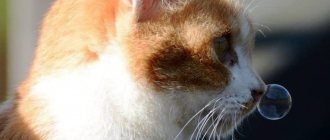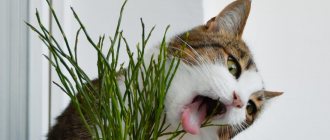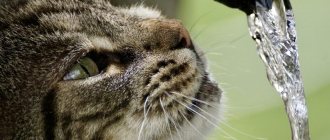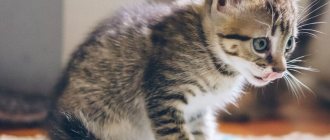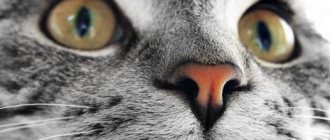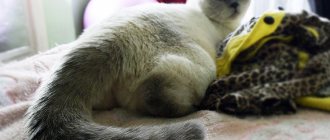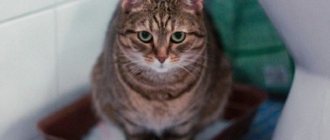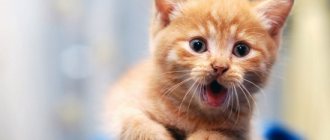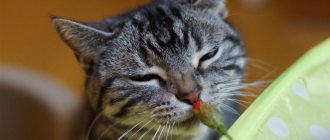Rapid breathing - normal variants
The normal breathing rate of a pet ranges from 20 to 40 breaths per minute. If a cat begins to breathe with greater intensity, this does not mean that he is necessarily ill. Often the reasons for such changes in breathing are:
- overexcitement, fear or rage;
- travel in any transport;
- being in an unfamiliar place;
- visiting a veterinary clinic and taking medications;
- physiological changes in the cat’s body (estrus, pregnancy, childbirth);
- active games, walks, exercise, etc.;
- the process of eating food;
- overheat.
All of the above does not pose a danger to your pet. Usually after some time (after finishing the game, normalizing the emotional state, finishing eating, etc.), breathing is restored.
Dangerous symptoms if a cat breathes with its belly
Sometimes, during difficulty breathing, the pet may experience pain. Externally, this manifests itself as the following signs:
- the cat looks excited and scared;
- the muzzle is stretched out in an unusual grimace;
- pupils dilated;
- the tail is pressed to the body;
- mustache pressed;
- the animal is aggressive.
Heavy belly breathing is a sign that your cat is not feeling well. It looks as if the pet is trying to inhale air with its stomach and push it out when exhaling. This type of breathing is called abdominal.
Normally, the abdominal muscles should not be used. When healthy, there is a vacuum in the sternum around the lungs. It allows the lungs to expand when inhaling.
In case of injury or serious illness, air (pneumothorax) or liquid (hydrothorax) may enter the chest cavity, which is why the lungs cannot expand normally and take in air when inhaling.
The compensatory functions of the body are involved: the diaphragm is included in the inhalation process, so it is carried out by the “stomach”.
Shortness of breath in cats always indicates that the animal is unhealthy and requires increased attention from the owner.
The cause can be both chronic and acute conditions:
- diseases of the respiratory system;
- progressive anemia;
- recent operations under anesthesia;
- diseases of the cardiovascular system.
Heavy breathing with an open mouth occurs due to oxygen starvation of the body. In this state, you can notice a pose that is not typical for the cat’s normal behavior. It looks like this: the pet spreads its front legs wide, stretches its head and neck (trying to straighten the trachea), opens its mouth and breathes with shortness of breath.
This condition indicates that oxygen from the inhaled air is not delivered to the organs and tissues of the body. As a result, hypoxia occurs - a serious, life-threatening condition.
Another cause of open-mouth breathing is a cat in shock. This is a severe circulatory disorder, also leading to hypoxia. This condition can occur due to injury, allergic reaction and intoxication of the body.
Heavy breathing with your tongue hanging out also indicates oxygen starvation. Sometimes such a reaction occurs in a cat after active physical activity. In this case, a blue tongue may appear. After resting a little, the cat returns to normal and all symptoms disappear.
When should you worry?
If you notice that the cat is inhaling air suspiciously often, while he may open his mouth slightly and stick out his tongue, then measures should be taken and a qualified specialist will help in this situation. Most likely, the furry will be diagnosed with pathological processes in the respiratory organs. It is possible that the diagnosis will reveal a disease that is not directly related to the respiratory system.
Feline health problems that lead to rapid breathing:
- Diseases of the throat and trachea (edema, paralysis, collapse, oncology, etc.).
- Pathological processes in the bronchi (helminthic infestations, bronchitis, asthma). Then the pet will additionally have a dry cough and fever.
- Pathologies of the nose in cats (inflammatory processes, infections). When a purr, along with rapid breathing, wheezing and discharge from the nose are observed.
- Lung diseases (blockage due to a large number of worms, oncology, edema, inflammation).
- Abundance of air in the chest.
- Hernias in the diaphragm.
- Neoplasms in the breast with changes in the diameter of the lymph nodes.
- Heart problems (any heart failure, arrhythmias).
- Intoxication.
- Diseases of the endocrine system, hormonal imbalances.
- Anemia.
- State of shock.
- Fever.
- Dehydration or severe overheating.
If, in addition to rapid breathing, you find that your beloved cat has begun to behave suspiciously, his temperature has risen, shortness of breath has appeared and his heart rate has increased, you can hear wheezing in the chest and there is discharge from the mouth and nose, there is paleness or redness of the mucous membranes, then without hesitation, take the mustache to the veterinary clinic for diagnostics.
What to do if your cat is breathing frequently?
The normal number of breaths a cat takes is between twenty and forty times per minute. However, sometimes owners observe deviations. If a cat is breathing frequently, this may indicate both various health problems and a reaction to certain external or internal factors of a temporary nature. It is imperative to find out the reason. Perhaps the animal needs help.
When rapid breathing is normal
Let's look at situations where a cat is breathing a little faster than usual, and this is normal. This phenomenon may be explained by the fact that the animal:
- scared;
- overexcited;
- got to a new place;
- angry;
- overeat;
- just a minute ago it was actively running or jumping.
shutterstock
Any emotional or physical stress can make a cat lose its breath. This is especially noticeable when the animal, for example, is transported, or it finds itself in other unusual conditions. A cat may also pant frequently when she is in heat, during pregnancy or childbirth. All these are variants of the norm. In this case, breathing problems are temporary, the situation quickly returns to normal.
Alarming symptoms
It’s another matter when a cat breathes heavily and frequently, a day, two or even more passes, and breathing does not normalize. In this case, the animal looks sick, tired, and there are additional symptoms. Rapid breathing in a cat can be a sign of serious health problems. For example:
- infectious diseases of the upper respiratory tract;
- tracheitis;
- bronchitis;
- pneumonia;
- neoplasms or hernias in the respiratory system (they interfere with breathing);
- endocrine diseases;
- cardiovascular pathologies;
- poisoning;
- anemia;
- allergic reaction;
- rib injuries;
- damage to the brain or spinal cord;
- foreign body in the respiratory tract.
This is not a complete list of reasons why a cat may breathe frequently. Associated symptoms are:
- cough;
- wheezing;
- nasal discharge;
- elevated temperature;
- loss of appetite.
Rapid breathing can occur, as noted above, due to heart problems. In such a situation, additional symptoms include tachycardia, bluishness of the oral mucosa, and general weakness. Under no circumstances should they be ignored. This could cost the cat his life.
It should be understood that if an animal breathes frequently, it does not have enough air. This leads to hypoxia (oxygen deficiency), which painfully affects all systems and organs. Destructive processes are launched. The cat may fall into a coma and die.
Owner actions
If a cat inhales suspiciously often, but his overall condition is satisfactory, you need to take your pet to the clinic to find out the cause and then eliminate it. There are situations when you cannot hesitate for a second, and help must be provided immediately.
shutterstock
We are talking, for example, about cases when a cat has choked and therefore breathes quickly. You can help her by opening the animal’s mouth wide, stretching out its tongue and trying to remove a foreign object from the throat. If this does not work, the cat is taken by the hind legs, lifted and pressed quite firmly on the stomach. The foreign body should pop out and the pet will be able to breathe normally.
It is most difficult to provide assistance for serious problems with the heart and lungs. The cat breathes very heavily with them, breathing is very rapid, but at any moment it can disappear completely. There's no need to panic. It should be remembered that there are ten minutes to resuscitate a cat, even if it is not breathing and no heartbeat can be heard. Procedure:
- The cat is placed on a flat surface on its side. The spine should be perfectly straight - head, neck and back - at the same level.
- Next, the person clamps the pet’s mouth and breathes into its nose at intervals of approximately once every 2-3 seconds.
- To prevent the air from dissipating, you need to make a tube from your palm. When manipulating a kitten, the frequency of inhalations should be less, because tiny lungs cannot accommodate large volumes.
- If the pulse has disappeared, at the same time as the procedure described, you need to do an indirect cardiac massage.
Most cats can be saved in this way within the first 10-15 minutes, and they begin to breathe on their own. After normalization of the condition, you should definitely show the animal to a veterinarian. The doctor will order an examination (blood tests, ultrasound, x-rays, etc.) and prescribe treatment. Without taking any measures, you can be sure that the attack will recur. The disease will progress.
There are many factors why a cat may frequently breathe with its mouth open. The reasons are physiological and pathological. If breathing problems are not associated with external factors and do not go away for a long time, the cat must be examined and treated.
How to help your pet?
If the mustache is breathing rapidly and heavily after a physiological process (birth, walks, active games, etc.), then the owner just needs to wait a little until breathing is restored.
In some cases, the cat begins to inhale air more often during sleep; this also should not cause concern, since furry cats also dream and react emotionally to them.
The help that should be provided to the owner in the event of a problem depends on the reason that caused it.
- If breathing problems appear after vaccination. This symptom may indicate the onset of an allergy to the components of the vaccine. If rapid breathing occurs quickly (within 15-30 minutes after the injection), the mustache requires immediate qualified help - anti-shock therapy, which is why animals remain indoors in veterinary clinics for some time after vaccination. The appearance of breathing problems 3-4 hours after the procedure indicates that the vaccine has begun to act and that the immune defense is responding effectively. Additionally, the mustache may refuse treats, be lethargic, and may develop diarrhea and fever - all these manifestations are normal if their duration does not exceed the threshold of 24 hours.
- As a result of overheating. In this situation, the pet must be placed in a cool and quiet place, wrapped in a damp cloth and soldered with not too cold water. There are severe cases when your pet should be taken to a veterinary clinic or a specialist should be called to your home.
- After anesthesia. Here the cause may be pain or intoxication as a result of anesthesia. In the first case, you can give the pet a drug with an analgesic effect (it should be prescribed by a veterinarian), and in the second, the mustache needs professional therapy.
- During pregnancy. If the future tailed mother's breathing changes to rapidity, then this is the first signal of an imminent birth. At such a moment, the pet’s sensations rapidly change – she is either hot or cold, which affects breathing and heartbeat. The owner should not panic in this situation - this is a normal physiological process. But the animal must be taken to the doctor if it has been noticed that the pet is breathing frequently and heavily long before the onset of labor.
A cat breathes with its mouth open when giving birth
Cats usually give birth on the 60-70th day after mating.
Before lambing begins, she begins to worry and meow loudly, calling on her owner for help. The birth process begins with contractions, during which the cat breathes with an open mouth.
At this crucial moment, the animal requires an increased amount of oxygen, hence the open mouth syndrome.
It is noteworthy that after giving birth, the cat breathes through its mouth no less intensely. This time she needs oxygen in order to produce as much milk as possible for the offspring.
It is clear that the mother will feed the kittens for more than one day. Therefore, do not be surprised if you periodically notice an open mouth in a nursing cat.
Professional help
If a cat with rapid breathing is examined by a veterinarian, then first of all, the owner of the mustachioed creature should be told about the possible causes of the problem and, together with the veterinarian, exclude physiological factors. After a thorough examination of the pet, the veterinarian will work according to the following scheme:
- determine the temperature of a sick mustache, which will help confirm or exclude the infectious nature of the disease;
- will give directions for biochemical and clinical blood tests - necessary to detect anemia, diabetes or infections;
- will detect the presence of worms in the tail (if any);
- to exclude tumors in the chest area, problems with the heart and peritoneum, the doctor will give a referral for an ultrasound and x-ray;
- in particularly severe situations, thoracentesis may be required, when the chest wall is pierced, which helps to identify the presence of excess air or fluid in the organs;
In case of injuries and oncological development of the disease, in most cases surgical intervention is necessary. In other situations, drug therapy is prescribed, which directly depends on the diagnosis made by a specialist.
In a state of shock (rapid drop in blood pressure), the pet needs to quickly restore its respiratory rhythm, which is done with the help of adrenaline therapy, infusion therapy, various diuretics, corticosteroids, and analgesics.
Video
Shortness of breath in a cat or dyspnea is a disorder of the breathing process, expressed in changes in the frequency, depth and rhythm of respiratory movements. It can be both physiological and pathological in nature. In the latter case, dyspnea is a symptom of serious diseases.
Due to some differences in the physiology of dogs and cats, it is quite natural for a dog to have an open mouth with a protruding tongue during extreme heat. Thus, it regulates temperature (the body cools through the evaporation of saliva from the tongue). After all, animals do not have sweat glands on their bodies.
For a cat, an open mouth is an unnatural position, and she rarely resorts to it. In most cases, this indicates that the animal has health problems. That is why the owner should show concern in response to the appearance of this symptom in his pet. Let's take a closer look at what this phenomenon is.
As mentioned above, shortness of breath in a cat can be physiological or pathological.
In turn, pathological shortness of breath, based on the type of breathing disorder, can be divided into the following types:
- bradypnea – slow breathing when the functions of the respiratory center are suppressed;
- tachypnea – rapid shallow breathing. This is a characteristic symptom of fever, as well as anemia and other blood diseases.
In addition, there are several forms of shortness of breath, depending on which phase of breathing is disturbed:
- inspiratory dyspnea – the inspiratory phase is disrupted;
- expiratory shortness of breath – the expiratory phase is disturbed;
- mixed shortness of breath - both inhalation and exhalation are complicated.
Uneven breathing in a pet - actions of the owner
There are times when a pet’s breathing quickens, and after a while it disappears altogether. With this problem, a change in the shade of the mucous membranes from pink to blue may be observed. To help the mustache, the owner must follow the following algorithm:
- The pet must be fixed on a table or any other flat surface. The line from the neck to the end of the spine should be straight.
- Next, inspect the mouth of the mustache and clean it of mucus, saliva and other objects.
- Roll your palm into a tube (you will inhale air through it).
- Take a deep breath and exhale through a tube from your palm into your pet's nose. You can cover the cat's nasal cavity with a thin cloth and exhale through it, then you do not need to use your palm.
- Every three seconds, exhale into your pet's nose, but do not overdo it, as excessive air volume can have a detrimental effect on the lungs.
During the process, do not forget to monitor the pulse of the mustache; if it is absent, an indirect cardiac massage should be performed.
The above actions can save the life of your beloved creature, so do not wait for the doctor to arrive - act confidently and quickly. Subsequent therapy should be carried out under the supervision of a qualified specialist.
Associated symptoms
When a cat is brought to the doctor, first of all he asks about the signs that alerted the owner of the animal
Therefore, monitoring a presumably sick pet before visiting the clinic is very important. This helps to quickly make a diagnosis
Signs that accompany the development of pathology of the respiratory system are:
- poor appetite;
- wheezing when breathing;
- increased heart rate;
- elevated temperature;
- rapid pulse;
- redness or bluish tint of the mucous membranes;
- vomit;
- swelling;
- diarrhea;
- the appearance of mucous discharge from the mouth or nasal openings.
The effectiveness of treatment for your pet depends on the amount of time that has passed since the onset of alarming symptoms. There are diseases that develop very quickly. For example, pulmonary edema. Delay in such cases can cost the pet’s life.
What should a cat owner do?
If your pet is pregnant, then rapid breathing may be a sign of imminent labor, then you don’t need to do anything. If your cat is sticking out her tongue and breathing rapidly, and you know that she is very frightened by something, or has just had a lot of running, or is clearly suffering from the heat, you can try to alleviate her condition yourself by providing her with rest in a cool room.
If the cat appears to be choking, try to pry its jaws apart and remove the stuck foreign body with your fingers or tweezers. Or you can lift the cat by the hind legs and, pressing with the other hand on the stomach in the area of the diaphragm, try to squeeze out the foreign body.
But if the cause of rapid breathing is unclear to you, and even more so if shortness of breath is accompanied by symptoms such as rapid pulse, fever, wheezing in the chest, discharge from the mouth or nose, swelling or redness of the mucous membranes, general lethargy, lack of appetite - There is no need to waste time; you must urgently show the animal to a doctor. The speed of assistance depends on how fast and effective its results will be.
Important! Even in critical cases, the animal owner can provide first aid to his pet. If the cat's breathing is not only frequent, but also intermittent, and it is clearly visible that she is suffocating, you need to give her artificial respiration before the veterinarian arrives.
To do this, you need to place the cat with its back down on a flat surface, if necessary, clear its mouth of mucus, and then, folding your palm into a tube, blow air into the animal’s nose every three seconds
This must be done carefully so that too strong a stream of air does not damage the lungs.
When the veterinarian sees the cat, he will examine the animal, ask the owner about the possible causes of rapid breathing, measure the cat’s temperature, and, if necessary, blood pressure (in shock it usually drops significantly).
To identify infectious diseases, neoplasms, diseases of the endocrine system, blood disorders, and the presence of helminthic infestations, a veterinarian can prescribe laboratory, instrumental and hardware examinations to the cat:
- blood and urine tests,
- biochemical analysis of secretions,
- Ultrasound,
- X-ray.
Methods of therapy aimed at restoring the respiratory rhythm depend on the cause of its disturbance established by a specialist. If it turns out that rapid breathing is the result of a slow response of the immune system to the vaccine, the cat will be prescribed an antihistamine that blocks the production of allergy mediators - T-lymphocytes. To eliminate other causes, the use of analgesics, corticosteroids, diuretics, and adrenaline therapy may be necessary.
In some particularly severe cases, for example, when breathing problems in a cat are caused by an injury that cannot be removed by a foreign body, or by the presence of a neoplasm, surgical intervention may be required. However, such situations arise very rarely.
Reasons for meowing related to pathology
Often the reason why a kitten meows on the tray is various pathological phenomena
Some of them do not require treatment, while for others it is important to immediately visit a veterinarian
- Digestive disorders. When a kitten is one month old, and upon moving to a new home, it is abruptly transferred from mother’s milk to regular food, it often develops constipation, which is associated with a rapidly changing consistency of stool. Normally, it takes 2-3 days before getting used to a new food. If this does not happen and the constipation does not go away, one owner will not be able to cope with the disorder, and a visit to the veterinarian will be required.
- Helminthic lesion. If there are worms in the intestines, the kitten experiences great discomfort at the moment when it visits the tray, since feces moving towards the anus causes strong movement of the parasites. The kitten meows for a long time due to incomprehensible and unpleasant sensations inside.
- Inflammation of the paranal glands. It does not occur often in kittens. When sick, the cat screams when it goes to the toilet, as well as from any touch to the area near the anus. A visit to the veterinarian is required urgently.
- Ulcers in the intestines. They cause severe pain in the animal when visiting the toilet and make the kitten meow. There are streaks of blood in the stool. A visit to the veterinarian should be urgent.
- Cystitis. Inflammation of the bladder is painful and provokes frequent, scanty urination, during which the pet often meows loudly due to cutting pain. Treatment of the disease is carried out only with the involvement of a veterinarian.
If your pet meows and shows restlessness on the tray, it is unacceptable to leave the situation unattended. To exclude possible pathologies, you should contact a veterinarian; and also from the breeder, when purchasing a kitten, you should always find out whether he is accustomed to different foods or still eats only mother’s milk.
Why measure saturation during coronavirus?
Coronavirus saturation is measured to quickly detect life-threatening hypoxemia. In this way, the severity of the disease is determined and a decision is made on further actions: hospitalization, oxygen support, computed tomography.
In foreign literature there is the term “silent hypoxemia”, which appeared only recently, during the COVID-19 pandemic, when it became clear that a fairly large percentage of patients were admitted to the hospital with an acute lack of oxygen, disproportionate to the symptoms. It turns out that patients can breathe, do not choke, there is no strong cough and no fever, while the lungs are severely damaged, saturation is critically low, and additional oxygen is needed.
Can a patient with symptoms of coronavirus somehow suspect that he has a lack of oxygen due to pneumonia? Yes.
Why does saturation decrease during coronavirus?
Not all patients with COVID-19 have a decrease in saturation, but only with the development of a complication - viral pneumonia. A decrease in saturation indicates probable respiratory failure. If a coronavirus infection has penetrated the lung tissue, and a person’s immune system cannot cope with it, a destructive process begins in the lungs - the alveolar septa (and interstitium) are damaged and inflamed, and the alveoli themselves are filled with liquid exudate - normally they are filled with air and are the starting point of transportation oxygen to organs, including the heart and brain. Since there is no damage to the bronchial tree with coronavirus, a decrease in saturation in a patient may indicate a reduction in the functional areas of the lung tissue.
If coronavirus saturation is below 95%, the patient may be hospitalized.
